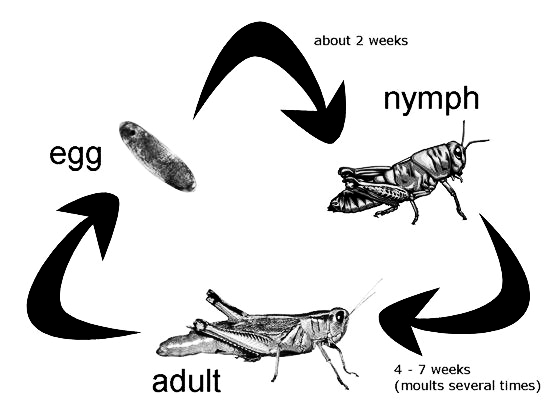
How many life- cycle stages do an incomplete metamorphosis have
A. 3
B. 4
C. 5
D. 6
Answer
542.7k+ views
Hint: Certain animals like insects and amphibians undergo changes during its life cycle. The animal exists in different forms during each stage. There are two types of metamorphosis, such as complete and incomplete.
Complete answer:
During incomplete metamorphosis, the larval stages look morphologically similar to that of the adult. The intermediate stage is called a nymph and is a miniature version of the adult. It is present during the development of several insects such as grasshoppers. Incomplete metamorphosis has three intermediate stages. The different stages are egg, nymph, and finally the adult. The egg hatches into the nymph. A nymph looks morphologically similar to that of the adult but possesses a thinner exoskeleton when compared to that of the adult. The nymph later develops into the adult through a process known as molting.

Considering the other given options:
-Four intermediate stages are commonly found in several insects undergoing complete metamorphosis such as butterflies. Here the intermediate larval stages have no similarity to the adult.
-Five intermediate stages are found during the life cycle of certain amphibians such as frogs. The process is complete metamorphosis.
-Six stages are not present during the life cycle of incomplete metamorphosis.
Therefore, by considering the above given options, the most appropriate option is A. That is, there are three intermediate stages during incomplete metamorphosis.
Note: Compared to incomplete metamorphosis, complete metamorphosis has a distinct larval stage. The larvae are very active and are continuously eating and then reach a dormant stage.
Complete answer:
During incomplete metamorphosis, the larval stages look morphologically similar to that of the adult. The intermediate stage is called a nymph and is a miniature version of the adult. It is present during the development of several insects such as grasshoppers. Incomplete metamorphosis has three intermediate stages. The different stages are egg, nymph, and finally the adult. The egg hatches into the nymph. A nymph looks morphologically similar to that of the adult but possesses a thinner exoskeleton when compared to that of the adult. The nymph later develops into the adult through a process known as molting.

Considering the other given options:
-Four intermediate stages are commonly found in several insects undergoing complete metamorphosis such as butterflies. Here the intermediate larval stages have no similarity to the adult.
-Five intermediate stages are found during the life cycle of certain amphibians such as frogs. The process is complete metamorphosis.
-Six stages are not present during the life cycle of incomplete metamorphosis.
Therefore, by considering the above given options, the most appropriate option is A. That is, there are three intermediate stages during incomplete metamorphosis.
Note: Compared to incomplete metamorphosis, complete metamorphosis has a distinct larval stage. The larvae are very active and are continuously eating and then reach a dormant stage.
Recently Updated Pages
Master Class 12 Business Studies: Engaging Questions & Answers for Success

Master Class 12 Economics: Engaging Questions & Answers for Success

Master Class 12 English: Engaging Questions & Answers for Success

Master Class 12 Maths: Engaging Questions & Answers for Success

Master Class 12 Social Science: Engaging Questions & Answers for Success

Master Class 12 Chemistry: Engaging Questions & Answers for Success

Trending doubts
What is meant by exothermic and endothermic reactions class 11 chemistry CBSE

Which animal has three hearts class 11 biology CBSE

10 examples of friction in our daily life

One Metric ton is equal to kg A 10000 B 1000 C 100 class 11 physics CBSE

1 Quintal is equal to a 110 kg b 10 kg c 100kg d 1000 class 11 physics CBSE

Difference Between Prokaryotic Cells and Eukaryotic Cells




